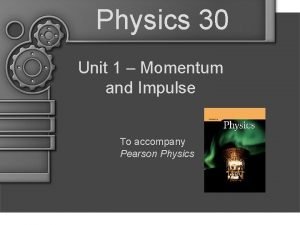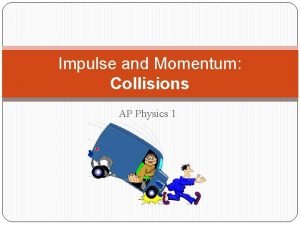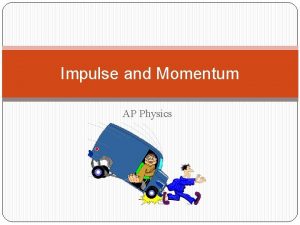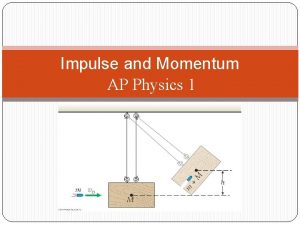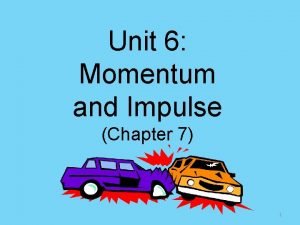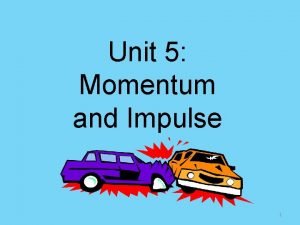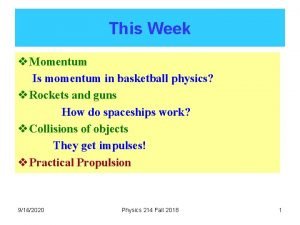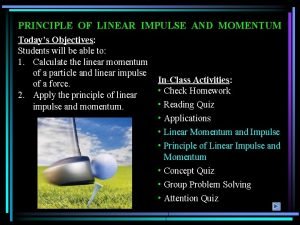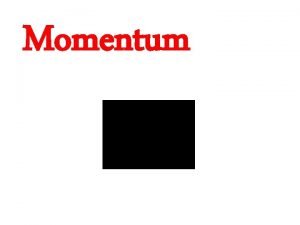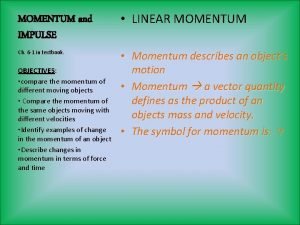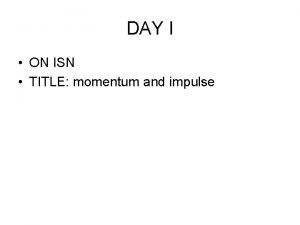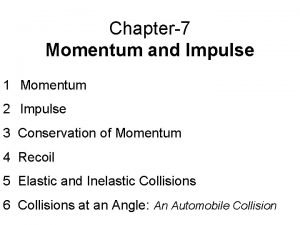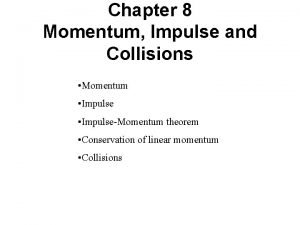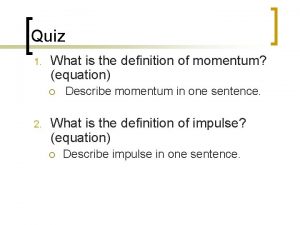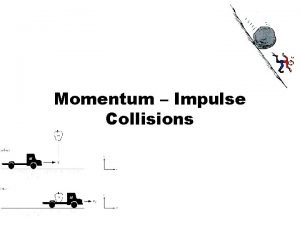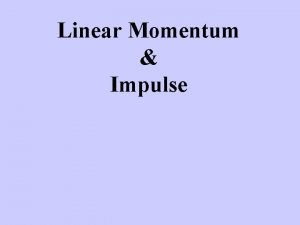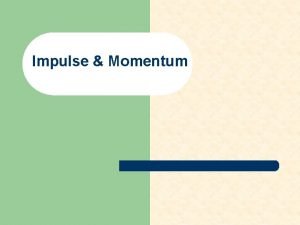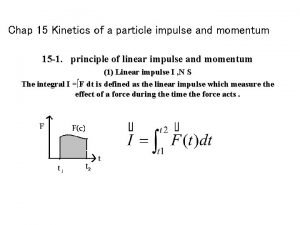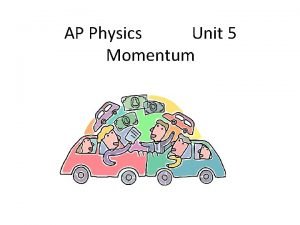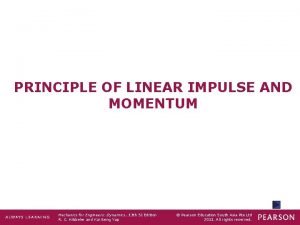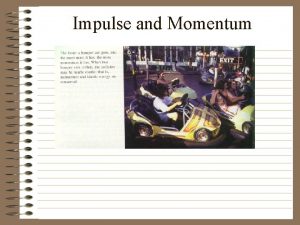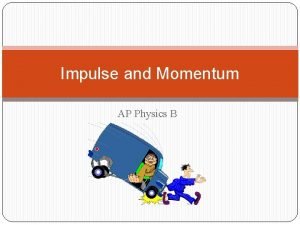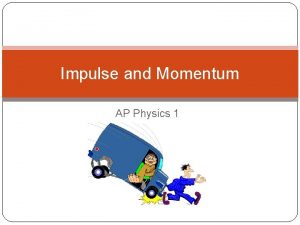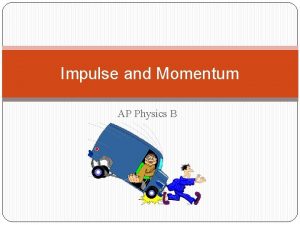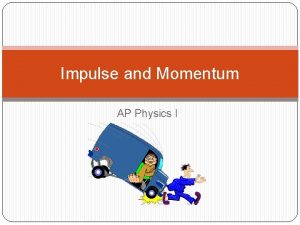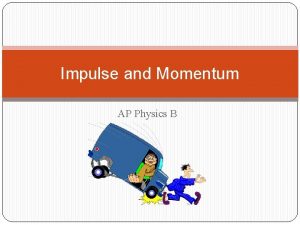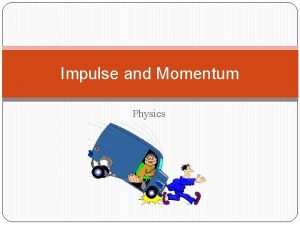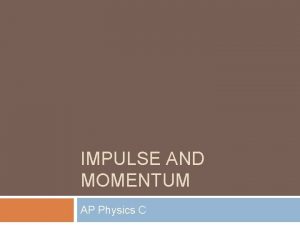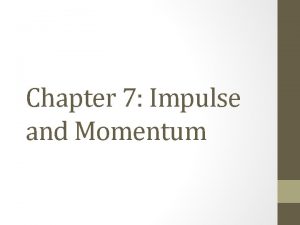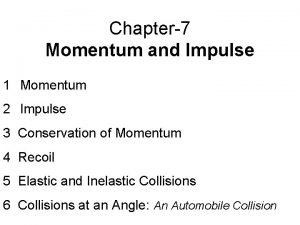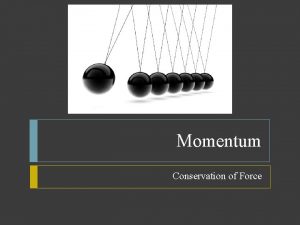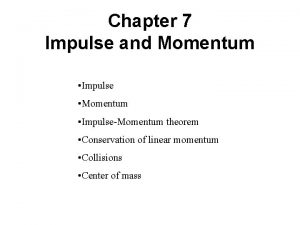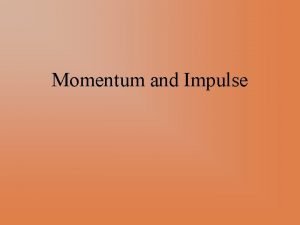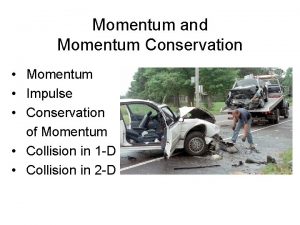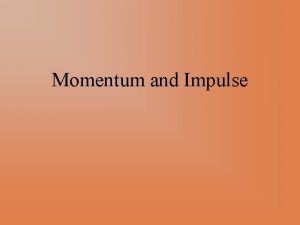Impulse and Momentum Honors Physics Lets start with

























- Slides: 25

Impulse and Momentum Honors Physics

Let’s start with everyday language What do you say when a sports team is on a roll? They may not have the lead but they may have ______ MOMENTUM A team that has momentum is hard to stop.

What is Momentum? An object with a lot of momentum is also hard to stop Momentum = p = mv Units: kg∙m/s^2 m=mass v=velocity Momentum is also a vector (it has direction)

Let’s practice A 1200 kg car drives west at 25 m/s for 3 hours. What is the car’s momentum? Identify the variables: 1200 kg = mass 25 m/s, west = velocity 3 hours = time P = mv = 1200 x 25 = 30000 kg m/s^2, west

How hard is it to stop a moving object? To stop an object, we have to apply a force over a period of time. This is called Impulse = FΔt Units: N∙s F = force (N) Δt = time elapsed (s)

Impulse = Momentum Consider Newton’s 2 nd Law and the definition of acceleration Ns Units of Impulse: Kg x m/s Units of Momentum: Momentum is defined as “Inertia in Motion”

Impulse – Momentum Theorem IMPULSE CHANGE IN MOMENTUM This theorem reveals some interesting relationships such as the INVERSE relationship between FORCE and TIME

Impulse – Momentum Relationships

Impulse – Momentum Relationships Constant Since TIME is directly related to the VELOCITY when the force and mass are constant, the LONGER the cannonball is in the barrel the greater the velocity. Also, you could say that the force acts over a larger displacement, thus there is more WORK. The work done on the cannonball turns into kinetic energy.

How about a collision? Consider 2 objects speeding toward each other. When they collide. . . Due to Newton’s 3 rd Law the FORCE they exert on each other are EQUAL and OPPOSITE. The TIMES of impact are also equal. Therefore, the IMPULSES of the 2 objects colliding are also EQUAL

How about a collision? If the Impulses are equal then the MOMENTUMS are also equal!

Momentum is conserved! The Law of Conservation of Momentum: “In the absence of an external force (gravity, friction), the total momentum before the collision is equal to the total momentum after the collision. ”

Types of Collisions A situation where the objects DO NOT STICK is one type of collision Notice that in EACH case, you have TWO objects BEFORE and AFTER the collision.

A “no stick” type collision Spbefore -10 m/s = Spafter

Types of Collisions Another type of collision is one where the objects “STICK” together. Notice you have TWO objects before the collision and ONE object after the collision.

A “stick” type of collision Spbefore 5 m/s = Spafter

The “explosion” type This type is often referred to as “backwards inelastic”. Notice you have ONE object ( we treat this as a SYSTEM) before the explosion and TWO objects after the explosion.

Backwards Inelastic - Explosions Suppose we have a 4 -kg rifle loaded with a 0. 010 kg bullet. When the rifle is fired the bullet exits the barrel with a velocity of 300 m/s. How fast does the gun RECOIL backwards? Spbefore = Spafter -0. 75 m/s

Collision Summary Sometimes objects stick together or blow apart. In this case, momentum is ALWAYS conserved. When 2 objects collide and DON’T stick When 2 objects collide and stick together When 1 object breaks into 2 objects Elastic Collision = Kinetic Energy is Conserved Inelastic Collision = Kinetic Energy is NOT Conserved

Elastic Collision Since KINETIC ENERGY is conserved during the collision we call this an ELASTIC COLLISION.

Inelastic Collision Since KINETIC ENERGY was NOT conserved during the collision we call this an INELASTIC COLLISION.

Example Granny (m=80 kg) whizzes around the rink with a velocity of 6 m/s. She suddenly collides with Ambrose (m=40 kg) who is at rest directly in her path. Rather than knock him over, she picks him up and continues in motion without How many objects do I have before the collision? "braking. " Determine the velocity of Granny and 2 Ambrose. How many objects do I have after the collision? 1 4 m/s

Collisions in 2 Dimensions The figure to the left shows a collision between two pucks on an air hockey v. A table. Puck A has a mass of v. Asinq 0. 025 -kg and is moving along the x-axis with a velocity of +5. 5 m/s. It v. Acosq makes a collision with puck B, which has a mass of v. Bcosq v. Bsinq 0. 050 -kg and is initially at v. B rest. The collision is NOT head on. After the collision, the two pucks fly apart with angles shown in the drawing. Calculate the speeds of the pucks after the collision.

Collisions in 2 dimensions v. Asinq v. Acosq v. Bsinq

Collisions in 2 dimensions
 Work energy theorem
Work energy theorem Physics 30 momentum and impulse
Physics 30 momentum and impulse Impulse symbol
Impulse symbol Impulse and acceleration
Impulse and acceleration Impulsive force
Impulsive force Ap physics momentum and impulse
Ap physics momentum and impulse Unit 6 momentum and impulse
Unit 6 momentum and impulse Unit of momentum and impulse
Unit of momentum and impulse Momentum in basketball physics
Momentum in basketball physics Linear impulse momentum equation
Linear impulse momentum equation Linear impulse and momentum
Linear impulse and momentum The importance of momentum
The importance of momentum Use of momentum and impulse as safety equipment in vehicles
Use of momentum and impulse as safety equipment in vehicles A 2250 kg car traveling to the west slows down
A 2250 kg car traveling to the west slows down Importance of momentum and impulse
Importance of momentum and impulse Momentum and impulse formula sheet
Momentum and impulse formula sheet Momentum s.i unit
Momentum s.i unit The momentum principle
The momentum principle Whats the definition of momentum
Whats the definition of momentum Impulse and momentum
Impulse and momentum Linear momentum
Linear momentum Impulse and momentum
Impulse and momentum Impulse and momentum
Impulse and momentum Kinetics of a particle: impulse and momentum
Kinetics of a particle: impulse and momentum Impulse and momentum
Impulse and momentum Dynamics impulse and momentum solved problems
Dynamics impulse and momentum solved problems

